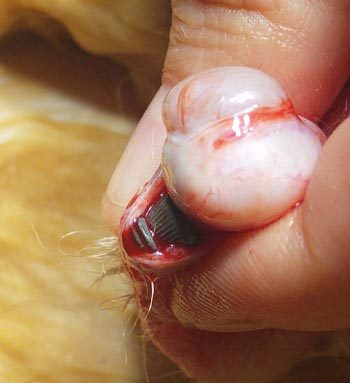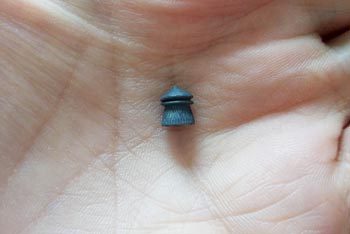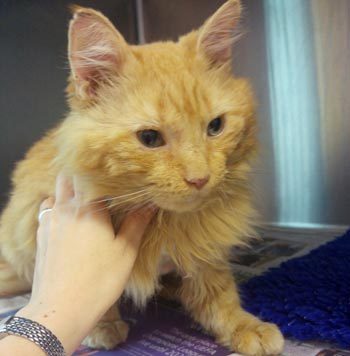24 Jul 2017
Kate Parkinson details the case of a feline patient that presented with a hard testicular swelling during routine castration, before discussing airgun injuries.

Figure 2. The pellet in situ.
A cat presented to the author for routine castration. During open castration, an airgun pellet was found lodged between the testicle and vaginal tunic. The pellet was removed without complications following open castration and the patient made a full recovery.
Airgun wounds are common in small animals and wildlife casualties. Pellets may present as incidental findings or be the inciting cause in traumatic injuries, and should be ruled out in all cases of unexplained trauma. Trauma patients should be radiographed and the location of pellets should be determined. CT scan is an alternative method of pellet location, although MRI is not recommended. Not all pellets need removing and some may be left in situ. Pellets may cause severe penetrating injuries, foreign body reactions and lead toxicity. At present, airgun licensing is not mandatory in England or Wales.
Although deliberate injury of an animal with an airgun is against the law and may be punished by harsh penalties, most cases are not witnessed and prosecution is unlikely.
An entire male cat of unknown age presented to the clinic for routine neutering. His owners reported the cat had been hanging around their house for several months and gradually moved in after they started feeding it. Following adoption, the owners presented the cat to the surgery for routine neutering. They had noticed no injuries or abnormal behaviour.
Pre-anaesthetic evaluation revealed a heart rate of 146, a respiratory rate of 20 and a temperature of 37.6°C, as well as numerous burrs caught in his coat.
Both testicles were confirmed to be present by digital manipulation. Many burrs were noted in the fur around this area. The owners declined preoperative blood work.
A total IM anaesthetic “triple combination” was used. Medetomidine 0.32ml (1mg/ml), butorphanol 0.16ml (10mg/ml) and ketamine 0.2ml (10mg/ml) were administered IM to good effect. An IV catheter was placed in the cephalic vein and oxygen was administered following intubation.
On surgical preparation of the area, a small, hard swelling was noted at the caudal extremity of the left testicle (Figure 1). The swelling was firm to the touch and had been mistaken for a burr on pre-neutering examination. The testicle was incised and an airgun pellet was found lodged between the scrotal skin and the vaginal tunic of the testicle (Figure 2). The pellet was easily removed with firm pressure (Figure 3).
Open castration was performed following pellet removal. The scrotum was left open to drain. Atipamezole 0.16ml (5mg/ml) was administered IM 40 minutes following induction to reverse the medetomidine component of the anaesthetic. Meloxicam injectable suspension for cats 0.44ml (2mg/ml) was administered SC post-neutering.
Open castration was curative in this case. Full body radiography was offered to the owners, who declined due to financial reasons. No further pellets were palpable on external manipulation of the cat’s entire body. Recovery was uneventful (Figure 4) and the cat’s owners were pleased with the outcome. A large quantity of burrs were clipped from the cat’s belly and inguinal region following castration.
Air rifles or airguns are small guns that use compressed air to fire a pellet. They are common weapons in the UK. Most airgun pellets have a distinctive shuttlecock or diabolo shape, so are easily distinguished on radiography or palpation. BB pellets are similar small, spherical, metal projectiles often used in airguns in the US and Canada. Unlike high-velocity projectiles, airgun pellets are relatively low velocity, and are more likely to retain their shape and less likely to fragment following impact.
Pellets are usually 4.5mm or 5.6mm in diameter, although alternative pellet sizes exist. Airguns are used for target and competitive shooting, hunting and pest control.
Gunshot wounds are relatively common in animals in general – cats in particular (Vnuk et al, 2015). In 2011, the RSPCA investigated 759 airgun attacks in animals across the country and this number increased to nearly 800 in 2012 (RSPCA, 2013). The UK press reported 202 cat shootings in the UK in 2016 (Cats Protection, 2017). These figures are likely to be only the tip of the iceberg, as most cases go unreported.

Although many pellets are found incidentally during routine examination or radiography, pellets have been found lodged in the eye (McKnight et al, 1988), aorta (Langelier, 1982), nasal passages (Henderson et al, 2004), spine (de la Fuente et al, 2013), limb (Arnault et al, 2011), and ureter (Röcken, 1986) of cats, and have been known to cause thromboembolism (Kettner and Kirberger, 2006). Airgun pellet injuries are unfortunately both common and well documented in children, and may be fatal (Bratton et al, 1997).
Airgun injuries are even more common in wildlife than pet animals. Multiple injuries are common in wildlife casualties. A well-publicised case in Staffordshire (Butler, 2017) involved a swan that was shot 10 times and, subsequently, euthanised. A hedgehog was also shot with an airgun in Norfolk in 2016 (The Telegraph, 2016). The pellet lodged in its spine, causing paralysis. The hedgehog was also euthanised. Both cases were investigated by the RSPCA.
Airgun pellets are relatively small, low-velocity projectiles. The point of entry is often small and can easily be missed, so check the patient carefully for puncture wounds. The injury may be much more serious than the entry wound suggests, with opportunity for severe penetrating trauma. Multiple pellets may be present, which may be retained or may pass through the body. Extensive clipping may be required to fully visualise the wounds.
The number of puncture wounds and intact bullets should add up to an even number – for example, two holes and no pellet means the pellet has passed through (Campbell, 2012). Some pellets are easily palpable under the skin. Palpable pellets may be confused with masses, displaced teeth or burrs, as in this case.
Radiography is the most common method of determining airgun pellet injuries and is routinely performed in trauma patients. Following stabilisation, any patients with suspicion of gunshot injuries should be radiographed and the location of pellets should be determined. Hypodermic needles or probes inserted into the wounds of an anaesthetised patient may serve as landmarks during imaging or guides during surgical exploration.
Airgun pellets are also easily seen on CT scan. Although most pellets are made from lead, MRI should not be carried out without knowledge of the composition of the pellet, as MRI scanning may be fatal in the presence of magnetic objects.
Exploratory laparotomy is indicated if any indication of recent abdominal penetration exists – for example, free abdominal gas or loss of detail on radiography, indicating free abdominal fluid. Even a non-lethal pellet entering the abdominal cavity may cause peritonitis, abscesses and adhesions. Due to their low velocity, pellet injuries are frequently contaminated, as the missile often drags hair into the wound.

It can take several days for bacteria to proliferate enough to cause infection. Pain relief and broad-spectrum antibiotics are indicated in the first instance, although further antibiotic use should be based on culture and sensitivity testing. Less seriously, a risk exists that the pellet may cause a foreign body reaction.
Although deep or vital projectile pellet injury may be lethal, airgun pellets are common incidental findings on radiography. Images should be interpreted with caution, as pellets may have been present for years and unrelated to the presenting clinical signs. If a pellet is not causing any problems, it is perfectly fine to leave it where it is. You may cause more damage attempting extraction than the pellet did initially.
Lead toxicity from retained pellets is, fortunately, rare. However, in acidic environments – such as the gastrointestinal tract, joint spaces or abscessed or bruised tissues – a risk exists of lead leaching from the pellet and causing toxicity. Fat and muscle tissue are insufficiently acidic for toxicity to develop (Dillman et al, 1979). Lead poisoning may occur years following the initial pellet injury. Clinical signs of lead toxicity in cats include weakness, seizures, anaemia, weight loss, blindness and death.
If toxicity is a concern, complete blood cell counts and blood lead levels may be monitored. Pellets are usually lead or lead alloy, although alternatives are available, such as tin or plastic projectiles. An online search of a popular shooting website (Pellpax, 2017) revealed 134 types of lead pellets for sale compared to 4 alloy pellets, 11 copper pellets and 1 polymer pellet. Most pellets available for sale were lead or lead alloy.
In 2001, the Home Office increased the age limit for buying or possessing airguns from 17 to 18 years old. Airgun owners and users in Northern Ireland and Scotland must be licensed. A total of 90 per cent of reported feline airgun shootings in the UK took place in England and Wales. At present, a high-profile Cats Protection campaign is calling for the licensing of airguns across the UK (Cats Protection, 2017). Unfortunately, most attacks on cats and other animals go unwitnessed, making it hard to prosecute. Incidents may be reported to police and/or the RSPCA by owners and vets.
The penalty for deliberately using an airgun to injure an animal can be up to six months in prison and a fine of £20,000 if found guilty under the Animal Welfare Act (2006; GOV.UK, 2006). Contrary to some popular opinions, it is illegal for a person to shoot a cat, even if it is on private property (Cats Protection, 2013). Additionally, under the Wildlife and Countryside Act (1981), it is an offence to kill, injure or take any wild bird (except those listed in Schedule 2 of the act) or any wild animal listed on Schedule 5 of the act, with a penalty of six months in prison and a fine of £5,000 (GOV.UK, 2017).

The recent, high-profile case of Franky Mills (UK Criminal Law Blog, 2017), who was prosecuted under criminal damage and firearms charges after shooting seven cats with an air rifle and sentenced to two years of youth detention, illustrated how the six-month maximum sentence may be exceeded if suspects are charged under criminal damage rather than animal cruelty offences.
Although, in this case, the pellet was an incidental finding and the cat in question recovered without incident, no doubt exists that airgun pellets can have serious consequences. Airgun attacks are common in small animals, such as cats and wildlife. Pellets are relatively small, low-velocity projectiles, but are, nevertheless, capable of causing serious injury in animals and humans.
Pellet injury should always be suspected while dealing with puncture wounds or cases of unexplained trauma. The injury may often be much more serious than the relatively small entry wound suggests, with opportunity for severe penetrating injury. The pellet may be retained or may pass through the body.
A risk of lead toxicity exists if the pellet enters acidic environments, such as the gastrointestinal tract, joint capsule or bruised or abscessed tissue. Whole-body radiography is an effective method of detecting pellets, as is CT scanning. MRI scanning is not recommended unless the exact composition of the pellet is known. Airgun licences are mandatory in Northern Ireland and Scotland, though not in England and Wales. The Animal Welfare Act (2006) prohibits deliberate injury of an animal by an airgun.
The author would like to thank Ginger the cat and his owner for permitting publication and photography of this case; the staff of Swaleside Veterinary Surgery in Sittingbourne, Kent; and Kristen Ganguzza for reviewing the article.